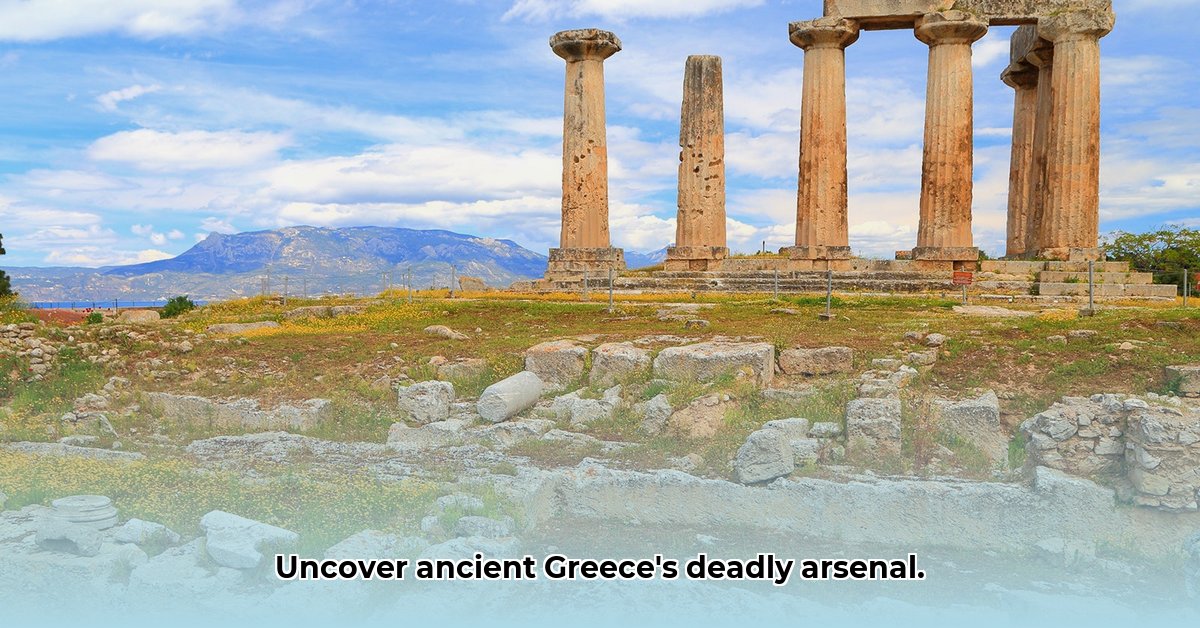Ever wonder what weapons the ancient Greeks used to conquer and defend their world? From the shiny bronze swords of their early heroes to the mighty siege weapons that brought down city walls, their military tech was impressive. This isn’t just a dry history lesson; we’re going on a journey through time, seeing how their weapons evolved, how they fought their battles, and even looking at some of the controversial aspects of their military history, like the mysterious “Greek fire.” To learn more about their defensive equipment, check out this article on Ancient Greek armor. Get ready to explore the spears, swords, shields, and more that shaped ancient Greece and left a lasting mark on warfare itself.
Ancient Greece Weapons: A Journey Through Time
Let’s explore the world of ancient Greek weaponry, from its Bronze Age origins to its sophisticated siege engines. We’ll uncover how these weapons shaped battles, reflected societal structures, and left a lasting mark on military history, considering their offensive and defensive capabilities.
Bronze Age Beginnings: Handcrafted Instruments of War
Imagine a time before mass production, when every weapon was a unique piece of artistry. That’s Bronze Age Greece (c. 3300-1200 BCE). Swords, spears, and axes weren’t just tools; they symbolized status and skill. Crafting them required exceptional talent and knowledge of metallurgy. Bronze, an alloy of copper and tin, was valuable, so only skilled artisans and wealthy individuals could afford these impressive weapons.
These early warriors relied heavily on individual combat skills, making each weapon a personalized tool for survival and dominance. Prominent weapons included the bronze sword (often leaf-shaped) and the spear, both effective in duels and small skirmishes. Shields, typically made of wood and covered in leather or bronze, offered vital protection. This period saw a focus on melee combat, with warriors striving for glory in one-on-one engagements.
Think of it as the ancient equivalent of a custom-made sports car—expensive, powerful, and reflecting the owner’s standing in society.
The Iron Age Revolution: A Weapon for the Masses
The introduction of iron weaponry marked a dramatic shift starting around 1200 BCE. Iron was more abundant and easier to work with than bronze, drastically reducing the cost of arms. This meant more soldiers could be equipped, fundamentally changing warfare. Armies grew larger, and tactics shifted towards coordinated fighting rather than individual duels.
Iron’s impact extended beyond affordability. Iron weapons, though initially less refined than their bronze counterparts, could be produced in greater quantities. This allowed for larger armies and new tactical doctrines. The era of the mighty warrior didn’t vanish, but the advantage now lay with well-trained and well-equipped groups working together.
This change set the stage for the famous phalanx formation, a powerful military strategy that would change the course of Greek history. The increased availability of iron also spurred innovation in defensive equipment, leading to more robust shields and helmets.
The Hoplite’s Arsenal: Citizen-Soldiers and Their Gear
The Classical period (c. 500-323 BCE) saw the rise of the hoplite, a citizen-soldier who formed the backbone of the Greek army. These were not professional soldiers, but ordinary citizens who contributed to the defense of their city-states. Their equipment reflected this civic duty.
The dory (a 2-3 meter long spear) was perfect for the close-packed phalanx formation, allowing for a coordinated wall of spear points. The xiphos (a 60 cm short sword), served as a secondary weapon for close-quarters combat when spears were broken or lost. The hoplon (a large bronze-faced shield, ~1 meter in diameter), provided crucial protection for the hoplite and his comrades. Often crafted from wood and faced with bronze, the hoplon was heavy but offered significant protection against spear thrusts, arrows, and blows from swords. The weight of the hoplon (around 7-8 kg) necessitated a tight formation, as each soldier relied on his neighbor’s shield for additional protection.
Owning this equipment was a significant investment, demonstrating both a commitment to military service and a certain degree of wealth. The hoplite’s gear wasn’t just about war; it was a symbol of civic pride and responsibility. Leather or linen armor (linothorax) provided some torso protection, while bronze helmets safeguarded the head. Greaves (shin guards) protected the lower legs, completing the hoplite’s panoply.
Did this emphasis on citizen-soldiers contribute to the unique political structures of ancient Greek city-states? The hoplite system fostered a sense of shared responsibility and civic participation, influencing the development of democratic and oligarchic systems in different city-states.
Beyond the Hoplite: A Diverse Arsenal
While the hoplite was iconic, other weapons played critical roles in ancient Greek warfare. The sarissa (an exceptionally long pike, 4-7 meters), later gained prominence in Macedonian armies, revolutionizing battlefield tactics. Invented by Philip II of Macedon, the sarissa’s extreme length allowed soldiers to engage enemies at a much greater distance, making the Macedonian phalanx nearly invulnerable from the front.
The curved kopis sword, favored for its slashing capabilities, provided a different approach to close-quarters combat. Often used by cavalry, the kopis’s heavy, curved blade allowed for powerful downward strikes, ideal for mounted combat. Other troop types included peltasts (light infantry) armed with javelins (akontia) and archers (toxotai) using composite bows.
This array of weapons highlights the diversity of warfare techniques and strategic approaches across the various Greek city-states, showing that there was no single “Greek way” of fighting. The varied equipment and specialized roles of different troop types reflected the diverse terrains and tactical needs of ancient Greek warfare.
Siege Warfare: Bringing Down the Walls
Ancient Greeks weren’t just masters of open battle; they were also ingenious siege engineers. Catapults and other siege weapons were used to bombard enemy fortifications. These weren’t simple slingshots; we’re talking sophisticated machines capable of launching massive projectiles over long distances, weakening defenses before a direct assault.
The helepolis (a giant mobile siege tower), was perhaps the ultimate symbol of Greek ingenuity in siege warfare. Constructed of wood and covered in protective materials, the helepolis was a towering structure that housed soldiers and siege engines. Movable on multiple wheels, it allowed attackers to approach city walls under cover, providing a platform for breaching fortifications.
The onager (a torsion-powered catapult) and the ballista (a larger, more powerful version of the crossbow) were employed to hurl stones, incendiary projectiles, and even dead animals over walls, causing both physical damage and psychological distress to the besieged. These machines required incredible engineering skill and logistical planning, showcasing the advanced technology of the ancient Greeks. Sieges were common occurrences in ancient Greek warfare, and the development of effective siege weaponry was crucial for conquering fortified cities.
Ranged Warfare: The Importance of Distance
Ranged weapons, like bows and arrows and slings, consistently played crucial supporting roles in ancient Greek warfare. These weren’t the primary weapons, but they were highly effective.
Archers (toxotai) could harass enemy formations, softening them up for a charge. Composite bows, made of layers of wood, horn, and sinew, provided greater range and power compared to simple wooden bows. Slings, unbelievably effective in skilled hands, were inexpensive and easy to use, making them an ideal tool for common soldiers. Slingers (sfendonetai) could hurl stones or lead projectiles with considerable accuracy and force, disrupting enemy formations and inflicting casualties from a distance.
Though often overlooked, these ranged weapons had a significant impact on the outcome of many battles and sieges. They complemented the close-quarters combat of the hoplites and added a valuable dimension to Greek military tactics.
Controversies and Uncertainties: Unveiling the Mysteries
Not everything about ancient Greek weaponry is clear-cut. The exact nature and effectiveness of “Greek fire”—a legendary incendiary weapon—is still debated. Its composition remains a mystery, with various theories suggesting ingredients like naphtha, sulfur, quicklime, and other flammable substances. Some argue that it was a revolutionary concoction, while others believe it was a variation of existing technologies.
Similarly, there’s ongoing debate about the use of biological and chemical warfare. While evidence suggests poisoned weapons existed, their prevalence and overall impact remain subjects of ongoing research and discussion. Historians and archaeologists continue to investigate ancient sources and archaeological findings to shed more light on these controversial aspects of Greek warfare.
The field is still actively being explored and may yield more information in the future.
A Legacy of Innovation and Adaptation
The evolution of ancient Greek weaponry closely parallels the development of their civilization. From the Bronze Age’s focus on individual combat to the coordinated power of the hoplite phalanx and the sophisticated siege engines of later periods, these weapons offer a glimpse into their societal shifts, military innovations, and relentless pursuit of dominance. The influence of these ancient implements of war extended far beyond their time, shaping military technology and tactics for centuries to come.
Weaponry Comparison Table
| Weapon Type | Material | Era | Role | Advantages | Disadvantages |
|---|---|---|---|---|---|
| Dory | Bronze/Iron | Bronze/Classical | Spear, Phalanx | Long reach, effective in formation | Vulnerable at close range |
| Xiphos | Bronze/Iron | Bronze/Classical | Short sword, backup weapon | Close combat, versatile | Limited range |
| Hoplon | Bronze/Wood | Classical | Shield, defensive armor | Excellent protection, formation defense | Heavy, cumbersome, limits mobility |
| Sarissa | Iron/Wood | Hellenistic | Long pike, Macedonian phalanx | Extremely long reach, impenetrable front | Requires specific formation, unwieldy |
| Catapult | Wood, Stone | Classical/Hellenistic | Siege weapon, ranged assault | Long range, high impact, siege breaking | Slow reload, vulnerable to counter-battery |
| Sling | Leather, Stone | All periods | Ranged weapon, harassment | Cheap, easy to use, long range | Limited accuracy, short range |
| Kopis | Iron | All periods | Curved sword, cavalry weapon | Powerful slashing attacks, versatile | Less effective for thrusting |
How did the effectiveness of Greek siege weaponry compare to that of their ranged weapons?
Let’s consider how efficient Greek siege weapons were, compared to ranged weapons. How did these tools determine military conflict outcomes?
Key Takeaways:
- The effectiveness of Greek siege and ranged weaponry varied greatly depending on the specific technology, the target, and the tactical situation. Siege weapons excelled at breaching fortifications, while ranged weapons provided battlefield control and harassment.
- Technological advancements in both siege and ranged weaponry were driven by ongoing conflicts between Greek city-states. The catapult, for example, enhanced stone-throwing capabilities.
- The transition from bronze to iron significantly impacted weapon design and military effectiveness across both siege and ranged capabilities. Iron enhanced arrowheads and strengthened siege engine components.
- Hoplite warfare relied heavily on close-quarters combat, while siege warfare and ranged weapons added layers of strategic depth. Ranged weapons covered hoplite advances, and siege engines minimized hoplite exposure during breaches.
- Debates surround the exact composition and efficacy of “Greek fire,” highlighting the complexities of understanding ancient technologies. “Greek fire” introduced a novel incendiary dimension, contrasting with conventional ranged and siege approaches.
Bronze Age Beginnings: The Dawn of Warfare
Early Greek warfare, during the Bronze Age (roughly 2700-1200 BCE), relied heavily on bronze weapons. Think swords, spears, and axes—all painstakingly crafted. These weapons were effective in individual combat. But how did those tools fare against fortified settlements?
Early sieges were primitive, often involving protracted blockades and attempts to breach walls with basic tools. Siege effectiveness was limited by technology. Besiegers might try to set fire to wooden gates or undermine walls, but these methods were slow and unreliable. Ranged weapons were limited to simple bows and slings, which had little impact on stone fortifications.
The Iron Age Revolution: A New Era of Warfare
The introduction of iron around 1200 BCE transformed weaponry. Iron was stronger, cheaper, and easier to produce than bronze. This led to longer, stronger spears (like the dory), and more effective swords (xiphos).
The impact on siege warfare was significant. Stronger weapons meant more effective battering rams. The increased availability of iron also fueled the development of more advanced tools for undermining fortifications. Ranged weapons improved with iron arrowheads and the development of more powerful composite bows, but their role remained primarily one of harassment rather than decisive assault.
The Hoplite Phalanx: A Wall of Shields
The Classical period (5th-4th centuries BCE) is synonymous with the hoplite phalanx. Imagine a wall of shields and spears, overwhelmingly effective in open battle. Hoplites, citizen-soldiers, were heavily invested in their equipment. A hoplite’s equipment – the spear (dory), short sword (xiphos), and large shield (hoplon) – was expensive and demonstrated their commitment to civic duty.
How did the effectiveness of Greek siege weaponry compare to that of their ranged weapons?
Hoplites themselves weren’t directly involved in sieges to the same extent as the broader army, but their equipment was a product of the same period of technological development. The phalanx was effective in open battle, but it was ill-suited for siege warfare. Breaking through fortified walls required different tactics and technologies.
Siege Engines: Bringing the Walls Down
Greek siege warfare evolved dramatically. They weren’t just relying on brute force anymore. Advanced siege engines, like catapults (oxybeles) and ballistae (lithoboloi), entered the scene. These torsion-powered machines could hurl enormous stones or projectiles over long distances, devastating enemy defenses.
Siege towers, allowing soldiers to scale walls, became more sophisticated. Undermining, though risky, was another tactic used to breach defenses. Catapults and ballistae had a much greater impact than ranged weapons, capable of demolishing walls and fortifications. Siege towers provided a protected means of assaulting walls, while undermining could cause walls to collapse unexpectedly.
Ranged Combat: Arrows, Stones, and Psychological Warfare
Ranged weapons played a crucial, if supporting, role in Greek warfare. Slings and bows provided a means of harassing enemy troops from a distance, weakening their formations before a close-quarters engagement. This was invaluable before a siege began or while attempting to prevent supplies from reaching a besieged city.
Archers and slingers could target defenders on walls, disrupting their ability to defend the city. Ranged attacks were also used to demoralize the besieged population, making their situation more desperate. Though not decisive on their own, ranged weapons played an important role in siege warfare.
Controversial Weaponry: “Greek Fire” and Beyond
Debates continue about the precise nature and effectiveness of “Greek fire,” a legendary incendiary weapon sometimes associated with the Byzantines, though its roots might extend further back to the Classical world. Similarly, the extent to which Greeks employed chemical or biological weapons is a subject of ongoing scholarly discussion.
These areas highlight the complexity of interpreting limited ancient evidence. “Greek fire,” if it existed in the form described in later sources, would have been a devastating siege weapon, capable of setting ships and fortifications ablaze. However, the lack of definitive evidence makes it difficult to assess its true impact.
[Further research is needed to clarify these disputed areas.]
Ancient Greek Siege Weaponry Innovations and Effectiveness Comparisons
What are the differences in success rate between catapults and battering rams when attacking ancient Greek fortifications?
Key Takeaways:
- Ancient Greek siege warfare evolved from basic blockades to sophisticated engine use. Innovations included torsion catapults for ranged bombardment and advanced mining techniques.
- Iron’s introduction revolutionized weapon design and tactics. Iron-tipped battering rams and stronger siege engine components enhanced offensive capabilities.
- Hoplite equipment reflected societal structures. The need for collective defense influenced the development of specialized siege weaponry beyond individual soldier armaments.
- Siege engines like catapults and the helepolis were crucial. Catapults provided ranged destruction while the helepolis enabled protected troop deployment near walls.
- Ranged weapons played a significant supporting role. Archers and slingers suppressed defenders, allowing siege engineers to work more effectively.
- Debates surround “Greek fire” and biological/chemical warfare use. These discussions highlight the ethical dimensions of military technology in ancient Greece.
- Greek siege technology influenced later military traditions. Roman siege tactics adopted and refined Greek innovations, impacting warfare across the Mediterranean.
Bronze Age Beginnings: The Dawn of Siege Warfare
Early Greek sieges relied heavily on simple tactics. Imagine soldiers using bronze swords and spears to assault walls. These early warriors lacked the advanced siege weaponry we associate with later periods. Bronze tools were the best they had.
Building siege ramps or towers was a slow, laborious process. Success often depended on sheer determination and attrition. Blockades and starvation were common tactics, as direct assaults were often costly and ineffective.
The Iron Age Advantage: A Technological Leap
The shift to iron weaponry marked a turning point. Iron was stronger, cheaper to produce than bronze, leading to more widespread access to weapons. This democratization of armed forces had an impact on both daily and military life, not just siege warfare.
Stronger weapons meant stronger defenses too! Think of the difference between a bronze-tipped spear and an iron one piercing through a wooden shield. The availability of iron also spurred the development of more effective siege tools, such as iron-tipped battering rams and improved mining techniques.
The Hoplite Phalanx and Its Limitations in Sieges
The famous hoplite phalanx, a tightly packed formation of heavily armored soldiers, dominated open battles. But, how effective was it against fortified cities?
The phalanx’s strengths were in close-quarters combat. However, scaling walls successfully meant changing tactics. Siege engines and other weaponry were needed to breach enemy defenses. They needed ways of fighting that were not the hoplite phalanx. The limitations of this system in sieges prompted the development of more specialized siege technology and tactics. Hoplites might participate in the assault after a breach was created, but they were not the primary siege troops.
Ancient Greek Siege Weaponry Innovations and Effectiveness Comparisons: Catapults and Beyond
The ingenuity of ancient Greek engineers shines through their siege machines. Catapults of various designs hurled massive projectiles over walls. The helepolis (a mobile, fortified siege tower), provided cover during assaults.
They were effective but not always the perfect solution. A catapult’s range and accuracy depended on many factors, including the skill of the operator and the quality of the construction. The helepolis was vulnerable to counterattacks if not properly protected. Battering rams, while effective against gates and weaker sections of walls, were also vulnerable to defenders who could drop heavy objects or set them on fire.
Ancient Greek Siege Weaponry Innovations and Effectiveness Comparisons show how Greek engineers adapted their designs to meet specific challenges.
| Weapon | Advantages | Disadvantages | Effectiveness Comparison |
|---|---|---|---|
| Catapults (various types) | Range, high damage potential, versatility | Accuracy issues, slow reload, complex design | High against fortifications, moderate in open battle |
| Helepolis | Protected assault, psychological advantage | Slow, cumbersome, vulnerable to counterattacks | High against weak defenses, lower against strong defenses |
| Battering Rams | Direct assault, potentially quick breakthrough | Vulnerable to counterattacks, requires close proximity | High against weak gates/walls, low against strong defenses |
Overall, catapults were more effective at damaging fortifications from a distance, while battering rams offered a more direct, though riskier, method of breaching gates and walls.
Ranged Weapons: Supporting the Siege
Bows, slings, and javelins provided invaluable support during sieges. They could harass defenders on the walls, thinning their numbers and demoralizing them.
Ranged attacks were a crucial element of any siege. They did not make up for a lack of siege engines but were often effective at breaking down enemy morale. Archers and slingers could target defenders, forcing them to take cover and reducing their effectiveness. Javelins could be used to set fire to wooden structures or harass soldiers attempting to repair damaged walls.
Controversial Aspects: Exploring “Greek Fire” and Beyond
The true nature of “Greek fire” remains shrouded in some mystery. Was it truly a secret incendiary weapon or more of a common incendiary mixture? Similarly, accounts of biological and chemical warfare must be treated cautiously. There is not enough evidence for them to be universally accepted.
Evidence is limited; therefore, their overall effectiveness is difficult to judge. The use of such weapons would have had significant ethical implications, but the extent to which they were actually employed remains uncertain.
[Further research is needed to clarify these disputed areas.]
Societal Impact of Ancient Greek Weapon Production and Distribution
Key Takeaways:
- The shift from bronze to iron weaponry drastically altered Greek warfare and society. Iron enabled larger armies and changed battle tactics.
- Hoplite equipment, particularly expensive, reflected the citizen-soldier ideal. Affording the hoplon and dory was tied to civic participation.
- Weapon production and distribution influenced social structures and political power. Control over weapon production could shift the balance of power between city-states.
- The development of advanced siege weaponry impacted city-state strategies. Defending against and deploying siege engines altered Greek warfare strategies.
- Debates surrounding “Greek fire” and biological warfare highlight ethical considerations. The potential use of such weapons raises questions about ancient Greek warfare ethics.
Bronze Age Beginnings: A Society Forged in Metal
Let’s start at the beginning. The Bronze Age saw the rise of sophisticated bronze weaponry. Think intricate swords, sturdy spears, and imposing axes.
These weren’t just tools of war; they were status symbols. Access to bronze, a relatively rare material, marked a warrior’s place in society. Skilled artisans who could craft these weapons held a position of respect and influence. The Societal Impact of Ancient Greek Weapon Production and Distribution in this era was clear: wealth and power were directly linked to military might.
Imagine the prestige of owning a finely crafted bronze weapon — a symbol of both skill and social standing. The elite warriors who wielded these weapons often held positions of leadership and authority within their communities.
The Iron Age Revolution: A New Era of Warfare
The introduction of iron fundamentally changed the game. Iron was cheaper and more readily available than bronze, leading to a wider spread of weaponry. This resulted in larger, more heavily armed armies and significantly impacted military tactics.
The rise of the hoplite phalanx, a tightly formed infantry unit wielding spears and shields, exemplified this change. The Societal Impact of Ancient Greek Weapon Production and Distribution now extended beyond the elite; a larger segment of the population could participate in warfare. This had a profound impact on Greek society, fostering a sense of shared identity and civic responsibility.
Think of it as a democratization of military power, if even a limited one. The ability to arm a larger portion of the population allowed Greek city-states to field armies that could challenge larger, more centralized empires.
Hoplites and the Phalanx: Citizen-Soldiers and Their Gear
The hoplite phalanx epitomized the relationship between weaponry, military organization, and society. Each hoplite – a citizen-soldier – required significant equipment: a dory (spear), a xiphos (short sword), and a hoplon (shield).
These items were costly. Therefore, only the relatively wealthy could afford to serve. This dynamic directly shaped the political landscape and the nature of warfare, showing the deep connection between military capability and wealth. The Societal Impact of Ancient Greek Weapon Production and Distribution was deeply intertwined with the political structure itself. Participation in the phalanx was often linked to political rights and responsibilities, further blurring the lines between military service and civic life.
Beyond the Hoplite: A Wider Arsenal
Greek warfare was not solely about the hoplite phalanx. Siege warfare, for example, relied upon powerful machines like catapults and battering rams, impacting the strategy of conquests.
Ranged weapons like slings and javelins played crucial roles in combat. The design, manufacture, and distribution of these diverse weapons all had extensive social implications and shaped the battlefield’s dynamics significantly. The production of siege engines required specialized knowledge and resources, often concentrated in the hands of a few skilled engineers and wealthy patrons. Ranged weapons, on the other hand, could be produced more easily and were often used by poorer citizens who could not afford hoplite equipment.
Consider, even the humble sling, a simple yet effective weapon that could be crafted from readily available materials, played a role in battles across different social classes.
Controversies and Debates: The Gray Areas of Ancient Warfare
The historical record isn’t always clear. The very nature of “Greek fire,” a legendary incendiary weapon, remains debated. Similarly, the use of biological or chemical weapons is a contentious topic with limited concrete evidence.
These uncertainties highlight the limitations of our understanding of ancient warfare and the complexities of interpreting ancient texts and archaeological finds. Yet, such disputes demonstrate how the Societal Impact of Ancient Greek Weapon Production and Distribution was as often shaped by rumour and propaganda as by actual events. The fear of such weapons, whether real or imagined, could have a significant impact on military strategy and political decision-making.
- Discover Ancient Greece Weapons: A Comprehensive Guide to Military Technology - August 8, 2025
- Discover Ancient Greek Swords: A Comprehensive Guide - August 8, 2025
- Explore Ancient Athens: Unveiling the City’s Secrets Through Maps - August 8, 2025















